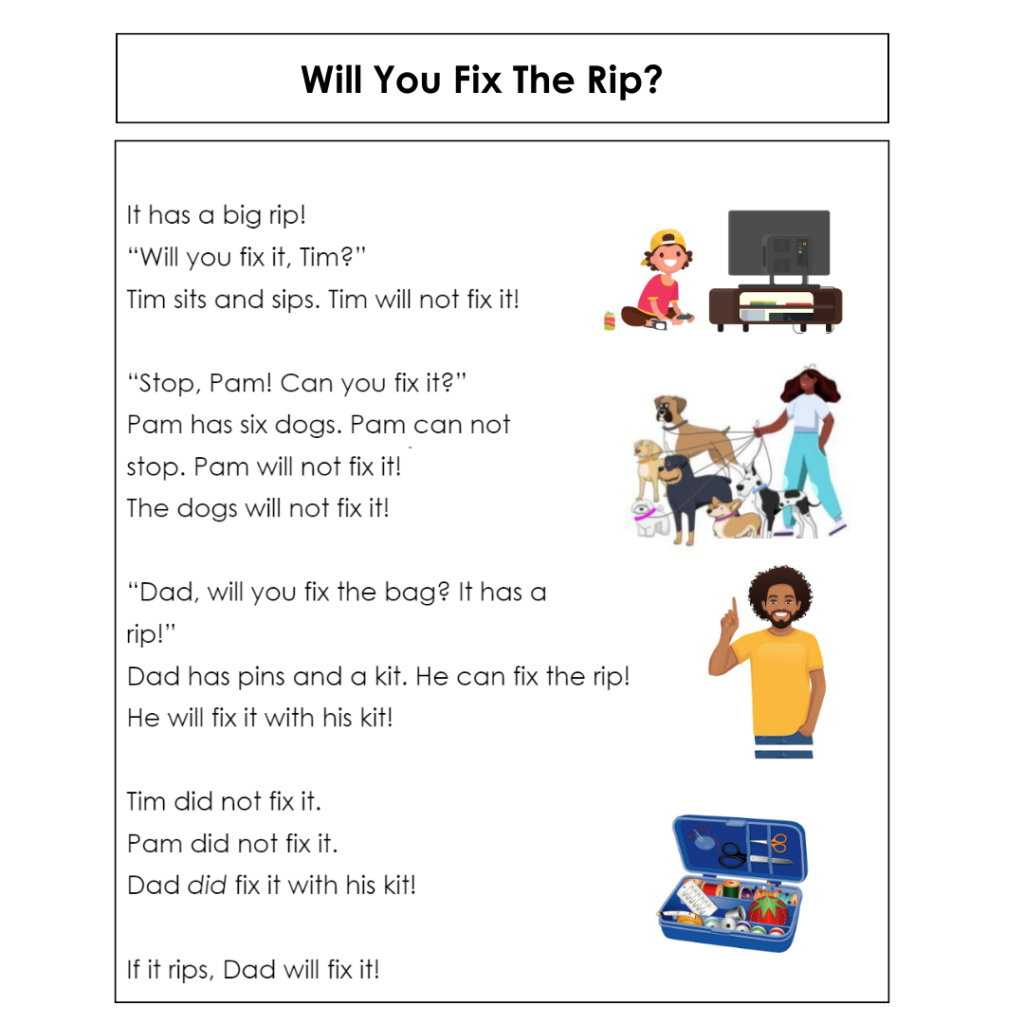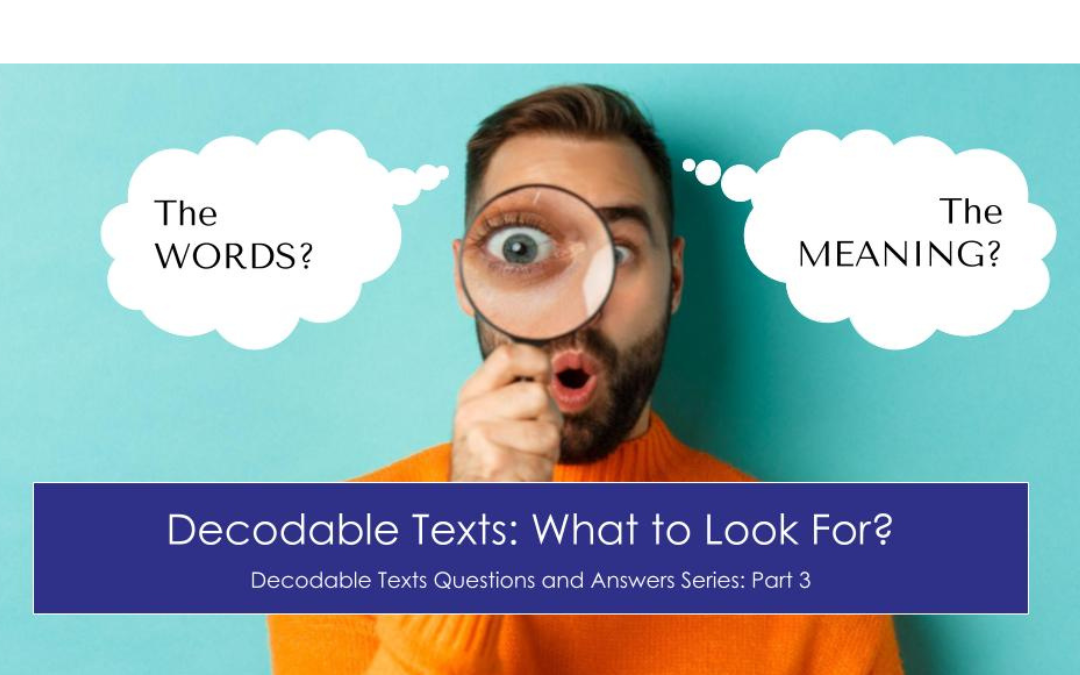In the last couple of blogs, we’ve unpacked these three questions about decodable texts:
- Who really needs decodable texts, anyway?
- What is a decodable text, really?
- How many decodable texts do I need?
- How do I know if a text provides the right mix of words for my students?
Next Time:
- What about meaning-making in decodable texts?
Maybe you’ve been looking through that dusty box of decodable texts you pushed to the back of your classroom cupboard a few years ago, hoping to find some that are usable. Maybe you’re lucky enough to be shopping for some brand-new decodables in an increasingly crowded market. Or maybe your school has already purchased a bunch of decodables, but you’ve started to realize there’s a lot of variation in the mix. Whatever the case, here are a number of considerations to keep in mind when evaluating decodable texts.
In this post, we continue the conversation and offer specific guidance for the crucial work of spotting what makes one decodable text a better match for your needs than another.
The search for decodable texts is a search for texts that will align with and extend your phonics instruction, as well as provide additional targeted practice opportunities for those students who need it, and build the confidence of beginning readers.
And although there is a lot to think about when trying to evaluate decodable texts, in the end, it boils down to two main considerations: the words and the meaning.
In this post and the next, we’ll take a look at these considerations using Will you Fix the Rip?, a short text we wrote to provide concentrated practice with short I while also offering a purposeful review of short A and short O. Today, we begin by considering THE WORDS.

You can download a copy of Will You Fix the Rip? here.
THE WORDS – How do I know if a text provides the right mix of words for my students?
When it comes to the print on the page, there are essentially three types of words to consider in any decodable text.
1. Decodable words
Most of the words in a decodable text should contain spelling patterns that have already been taught, including both current and previously taught sound-spellings. Of course, all words are decodable (more or less), but the important consideration is how decodable the words in a particular text will be for your particular students at this particular point in time. In other words (no pun intended), do the words align with what your students know about sound-spellings?
2. High-Frequency Words
These little words are often the glue that holds sentences together. Of course, many HFWs are completely decodable with basic phonics skills (can, and, went, it), so you don’t need to teach them individually and explicitly. But some HFWs have irregular spellings (the, you, said, want) and require specialized instruction. (We teach all about this in our Sight Word Success Mini-Course.) And some HFW will eventually be decodable but aren’t YET because children haven’t yet learned particular sound-spellings. These are temporarily irregular spellings. While every text will have high-frequency words, those with more than a couple of unknown high-frequency words (built with unknown spellings) are something to avoid if possible.
3. Content or Story Words
In decodable texts, there might be a few words that are important to the topic or story, even though they contain spelling patterns students don’t know. These words can be important for making the text appealing and for giving students something to think about. However, too many of them will take the text out of reach and defeat the whole purpose of a “decodable” text. When decodable texts do contain story or content words, you can handle that by previewing them before students begin reading and/or simply telling the students the words when they come to them. Look for decodable texts with a limited number of these types of words.
As the publishing industry responds to the demand for decodable texts that can be used flexibly with a variety of phonics programs, many have started to include specifics about the demands the words will place on the reader right in the text. This information is usually listed inside the front or back cover. This easy reference can help you decide if a decodable text is an aligned text for your students. But if you have texts that don’t provide this information, you’ll be amazed at how figuring it out for yourself can help you sharpen your decodability lens.
Here are some things to consider as you evaluate the mix of words in the text above, Will You Fix the Rip?:
- It has a high concentration of CVC words that provide practice with the identified focus skill. (i.e., fix, rip, Kim, it, sits, sips, will, pins, kit)
- It repeats some words without being so patterned or predictable that children don’t need to decode them. (i.e., it, rip, fix, did, six)
- It has only a few (or even less) irregularly spelled high-frequency words that might require explicit instruction (i.e., the, you)
- It interweaves earlier skills to provide a cumulative review (i.e., bag, Pam, dog, Mom, not, job).
So far, so good! In our next post, we offer considerations for thinking about the content of the text and how it engages children.
In the meantime, grab a few decodable (or even leveled) texts, and work to draw some conclusions of your own about how the words measure up to the needs of your students.
Binge our entire 6-part blog series about decodable texts!
Decodable Texts Q&A (Part 1): What? Why? Who?
Decodable Texts Q&A (Part 2): How Many is Enough?
Decodable Texts Q&A (Part 3): What to Look For? The WORDS.
Decodable Texts Q&A (Part 4): What Else to Look For – The MEANING.
Decodable Texts Q&A (Part 5): What About FREE Decodables?
Decodable Texts Q&A (Part 6): More Ideas for Getting Started!
-

Jan Burkins and Kari Yates are authors, speakers, and consultants, who are dedicated to helping teachers around the world translate reading science into simple instructional moves that help teachers make learning to read easier for their students while still centering meaning-making, engagement, and joy.
Recent Posts



Trackbacks/Pingbacks